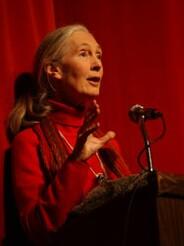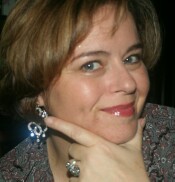Me Tongue-tied, You Jane

When I started this blog, I intended to write stories about my personal encounters with animals and other experiences of importance to me. So here is a story about the day I shared an elevator with Jane Goodall, the great scientist, activist and educator and my personal hero.
As a child, I wanted to be Jane Goodall. I couldn't imagine any life more exciting or interesting than hers. I did not grow up to be a primatologist, but I did, eventually, work briefly at The National Geographic Society, which has sponsored much of her work.
It was 1987 or '88. I was part of a team of researchers working on a special project, The Historical Atlas of the United States. One day, I had to ascend, for reasons I have forgotten, to an upper floor of the NGS headquarters building. We're talking deep silence, thick carpets, indirect lighting -- a posh and elegant eyrie for extremely elite eagles. This was the one and only time I ever dared to venture my humble-researcher toes up there.
I got into one of the miniscule elevators, which had a capacity of about four people. Two people were already inside, one of them a giant of a man with an immense video camera and a beard. The other person was a woman. Because of the crowded space, I ended up standing quite close to her.
I glanced at her sideways. She had delicate yet strong features, fine bones and the purest complexion imaginable. My first thought was, "That is the most beautiful woman I have ever seen."
My second thought was, "Omigod, that's Jane Goodall!"
It had taken me a couple of seconds to register that I was standing a couple of inches from the most famous primatologist in the world. I have no poker face; Jane and her companion could see every thought as it crossed my mind. I blurted out a strangled hello and blushed to the crown of my head. A tiny smile of amusement curved Jane's lips as her eyes met mine and she nodded to me.
The elevator stopped and I blundered out. They rode on, rising higher into the realm of the NGS gods, while I did a jig of uncontainable excitement in the empty elevator lobby. I wanted to shout: I just saw Jane Goodall! I just stood next to Jane Goodall! I just said hello to Jane Goodall!
I have seen her in person once more since then. In the mid-1990s, I attended one of her public lectures at a university. The lights of the vast auditorium were dimmed as a slender figure stepped up to the podium. In the glow of a small spotlight, she began to vocalize. The greeting of a wild chimpanzee filled our ears, rising from a series of increasingly excited pants to a frenzied scream of delight that echoed from the vaulted reaches of the ceiling. The hairs on the back of my neck stood up.
I think, although I'm not sure, that I hooted in reply.
Jane Goodall went to Tanzania in 1960, chosen by famed anthropologist Dr. Louis Leakey to conduct field studies of wild chimpanzees. In that same year, she made her first ground-breaking discovery: Chimpanzees make and use tools. With that, one of the most sacred barriers between man and animal was shattered. As Dr. Leakey said, "Now we must redefine tool, redefine man, or accept chimpanzees as humans."
The line separating human and nonhuman primates is thinner than we ever thought, and it's getting thinner all the time. The recent mapping of the chimpanzee genetic code has reduced the meaningful DNA difference between "us" and "them" to about one percent.
Jane Goodall now spends an average of 300 days a year on the road, travelling on behalf of chimpanzees, the environment and the future of the planet. She is tireless, apparently, and sublimely calm. One of the things I most admire about her is how centered she is. Despite the horrors she has seen inflicted on chimpanzees and nature, she remains always hopeful, always reasonable, always focused on solutions. She does not waste her time on vitriol and despair. She believes in education and the fundamental goodness of her fellow humans. She explains her optimism in an essay called My Four Reasons for Hope.
Jane Goodall is one of my reasons for hope.







3 Comments:
She's a hero of mine too. Can't believe you met her ....
Maybe you should write about why almost all the most important primatologists are women ... (it's our inbuilt empathy, innit!)
The question of how much DNA we share with apes is fascinating. There is also the possibility that there still exists in the wilder parts of Indonesia, another species of homo sapien ... where do we draw the line then between animal and human ...
elegant eyrie for extremely elite eagles
Such a great line I wish I'd written it myself.
She is an amazing speaker, isn't she? I just read a quote from her today:
Change happens by listening and then starting a dialogue with the people who are doing something you don't believe is right.
I think that is one of her most powerful gifts, the ability to put aside her anger and her sorrow and to persuade all kinds of people, even those on the opposite side of the issues from her, to try to change.
" ... I did a jig of uncontainable excitement in the empty elevator lobby ... "
Yes, I can just see you doing the above. :)
Post a Comment
<< Home